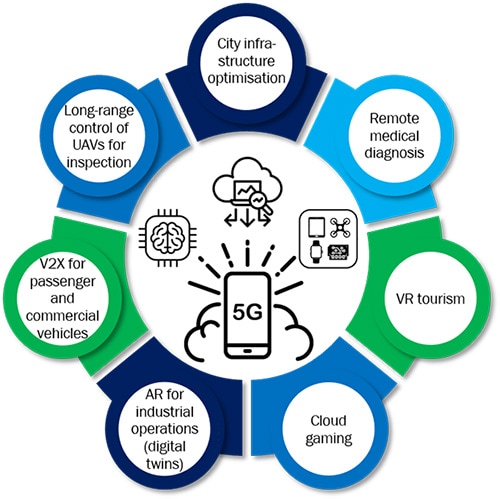Green 5G: Building A Sustainable World
The planet is facing a climate emergency which, if not tackled immediately, threatens every aspect of life. 5G is being deployed at a time when energy efficiency is a matter of life or death, and it can play a significant role in helping every industry to hit sustainability goals by enabling them to transform their processes and behaviour.
The 5G enabling effect arises from changes to processes and behaviour, which are supported by a high-capacity, ubiquitous and low-latency 5G network. Together with virtualisation, edge computing, AI-enabled analytics and cloud, 5G can help industries to implement new processes as an integral part of an energy efficiency programme, by supporting the most efficient and flexible allocation of resources. Figure 1.1 illustrates an array of use cases 5G can enable across multiple industry verticals. With enhanced mobile broadband (eMBB) underpinning many new ways to work and communicate, there has been considerable focus on ensuring that eMBB usage is as energy efficient as possible.

Figure 1: 5G’s enabling effect in other industry verticals
This intelligent use of resources can help to reduce energy consumption in many ways, such as: support for smart energy management; reduced requirement for office space and business travel; efficient just-in-time supply chains enabled by predictive analytics; and intelligent automated management of the movement of vehicles carrying people and goods.
Huawei and Analysys Mason have conducted analysis of the impact of 5G on energy efficiency in three industries which require energy efficiency transformation most urgently – energy, healthcare and manufacturing – all of which currently have high GHG emissions. The modelling involved lifecycle assessment (LCA) and operation parameter comparison. The research and modelling showed that, in these sectors, 5G can have a significant effect, when combined with other technologies such as cloud, AI and the Internet of Things (IoT), plus other changes such as the adoption of renewable energy sources.
To achieve the kind of results summarised above, governments, regulators, mobile network operators (MNOs) and the industries all have a part to play. This white paper sets out the details of what is achievable with the use of 5G, and what all these stakeholders need to do to make that happen, including:
- Governments can facilitate cooperation between different stakeholders to adopt common platforms and best practice.
- Regulators can lower barriers to 5G deployment by making spectrum and city infrastructure available in a timely and affordable way.
- MNOs can work to form strong relationships with all other stakeholders, to set common objectives and roadmaps for 5G-enabled efficiency, and ensure these are central to 5G planning and deployment.
It is only by all stakeholders, countries and industries working together that 5G can fulfil its maximum potential to enhance energy efficiency and help avert climate-change disaster.
